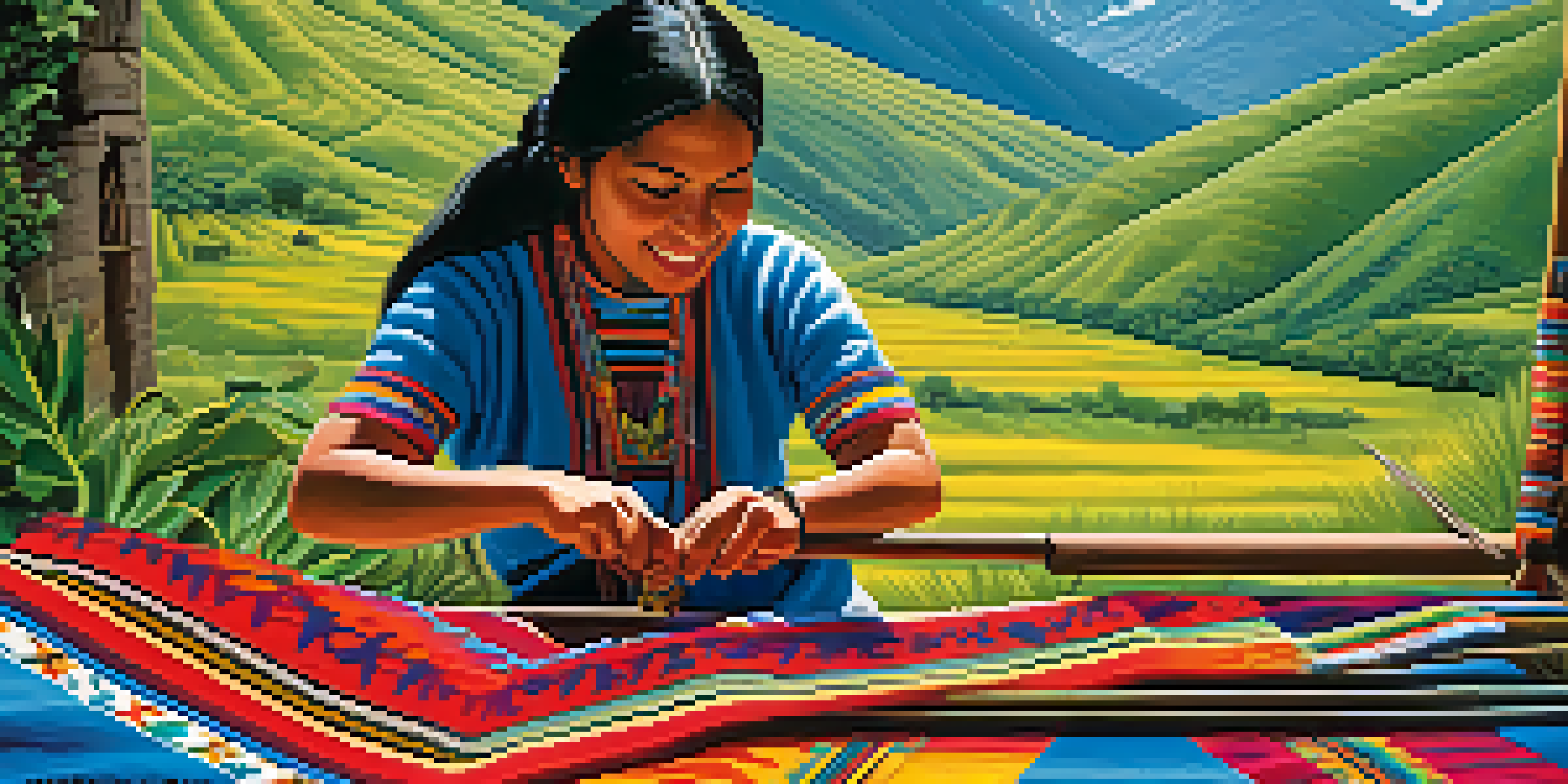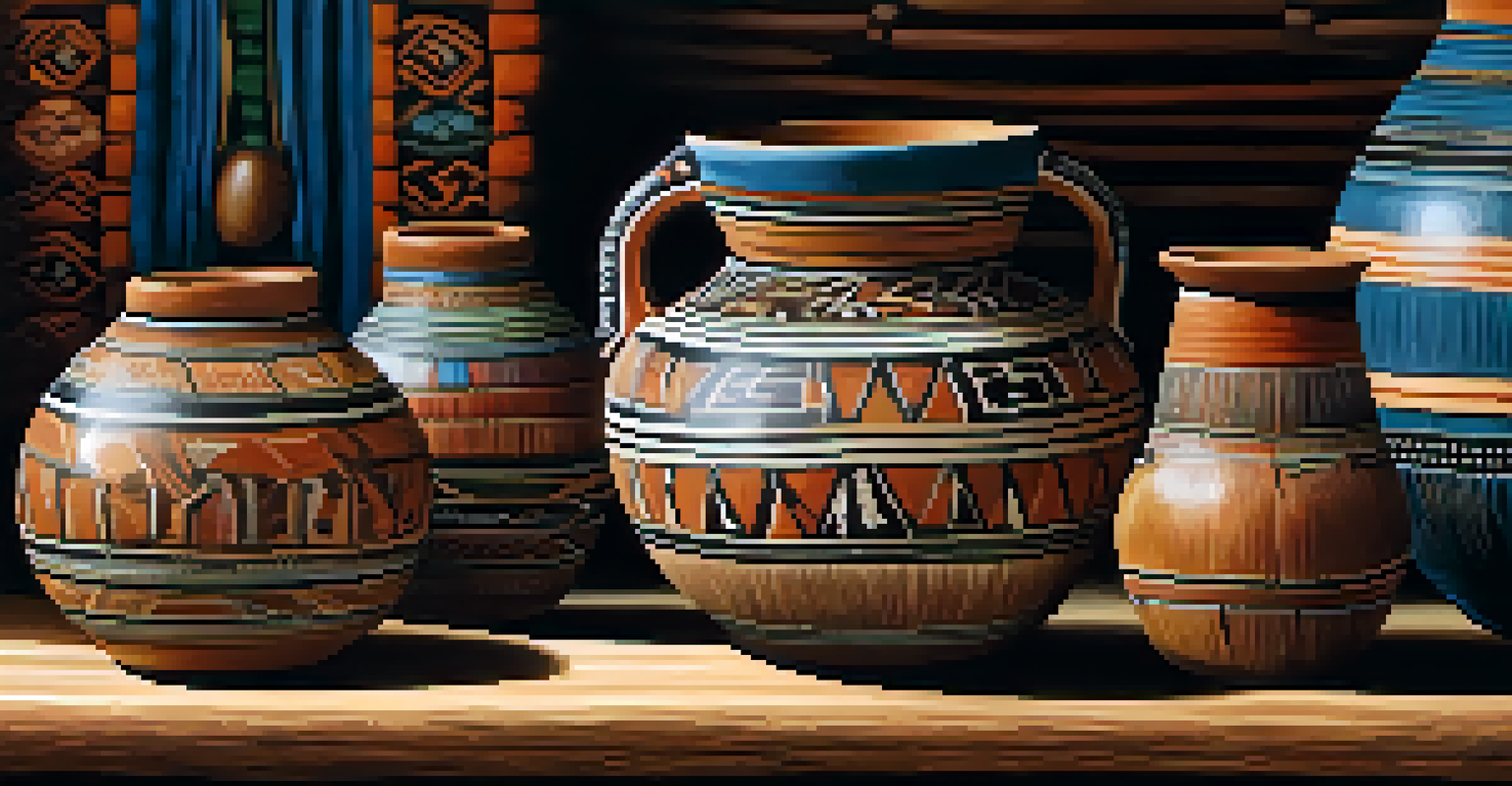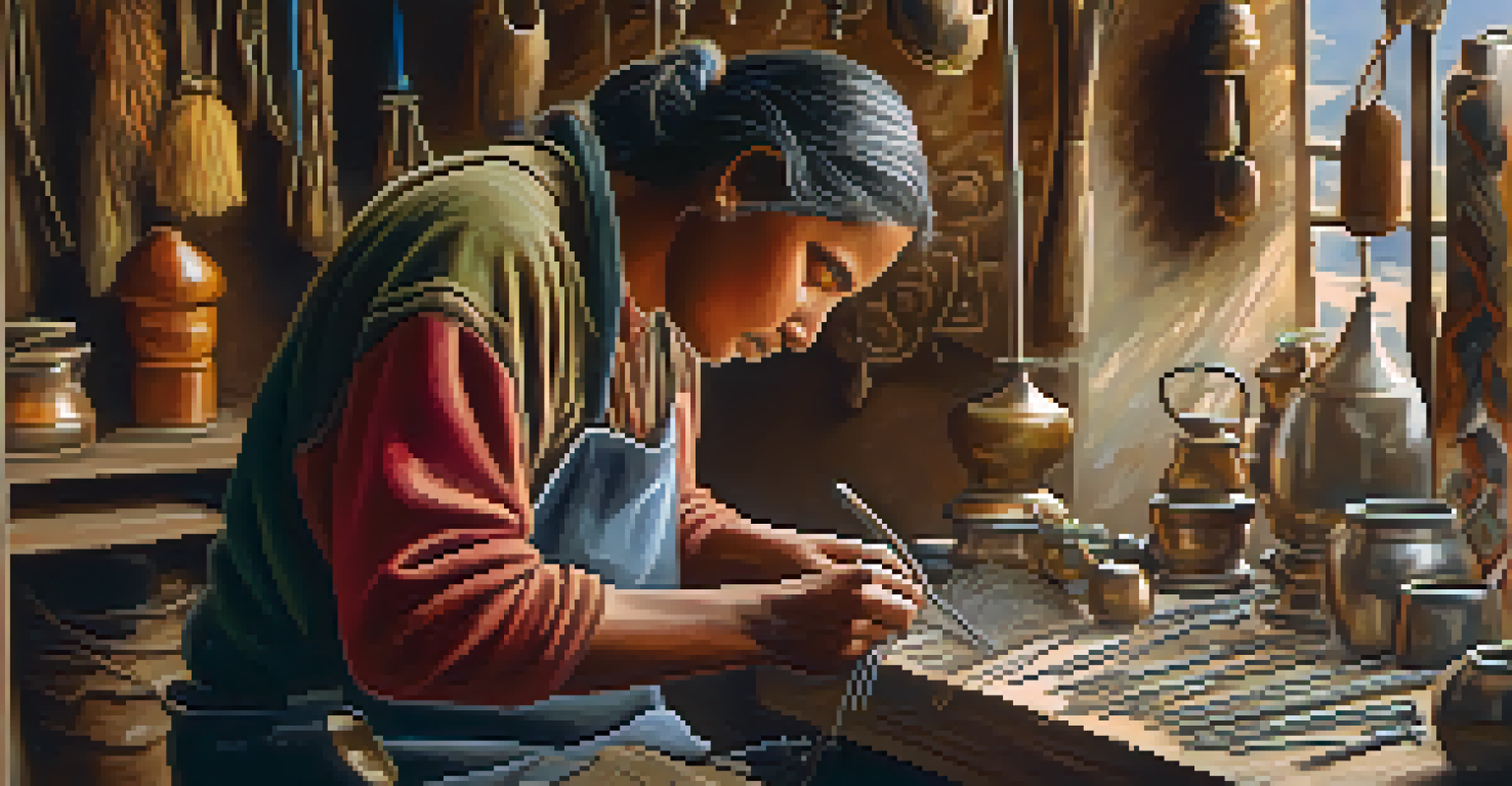The Legacy of Quechua Craftsmanship in Modern Peru

Understanding Quechua Craftsmanship and Its Roots
Quechua craftsmanship is deeply rooted in the cultural heritage of Peru, dating back to the Inca civilization. This rich tradition encompasses various art forms, including weaving, pottery, and metalwork, passed down through generations. Each piece tells a story, reflecting the community's connection to nature and their ancestral lineage.
Craftsmanship is not just about creating objects; it is about creating connections to our history and culture.
The expertise in these crafts is not merely about creating beautiful objects; it embodies a way of life for many Quechua people. For instance, weaving is not just a skill but a communal activity that fosters relationships and preserves cultural identity. This connection to their heritage is critical in a rapidly changing world, where globalization often threatens local traditions.
Today, many artisans continue to utilize age-old techniques while blending them with modern influences. This fusion allows them to maintain their identity while also reaching broader markets. As a result, Quechua craftsmanship remains vital to both cultural preservation and economic sustainability in contemporary Peru.
The Role of Weaving in Quechua Culture
Weaving is perhaps the most iconic aspect of Quechua craftsmanship, celebrated for its intricate patterns and vibrant colors. Each design carries symbolic meanings, often representing the natural world or significant cultural beliefs. For example, motifs may depict local flora or the Andean cosmovision, illustrating the artisans' profound connection to their environment.

Traditionally, women have been the primary weavers within Quechua communities, passing down techniques and knowledge to their daughters. This practice not only ensures the survival of the craft but also empowers women within their communities. As they create textiles, these artisans become storytellers, weaving their history and experiences into every piece.
Cultural Heritage of Quechua Crafts
Quechua craftsmanship reflects a rich cultural heritage, showcasing traditional art forms like weaving, pottery, and metalwork that are integral to the community's identity.
In modern times, Quechua weaving has gained international recognition, with many artisans participating in global fairs and exhibitions. This exposure allows them to showcase their skills while fostering pride in their heritage. The popularity of these textiles among consumers indicates a growing appreciation for handmade, culturally rich products.
Pottery: A Testament to Quechua Innovation
Quechua pottery is another significant aspect of their craftsmanship, characterized by its unique forms and decorative techniques. Traditional methods involve using local clay and natural pigments, which not only demonstrate the artisans' resourcefulness but also their deep respect for the environment. Each pottery piece serves both functional and decorative purposes, often used in community rituals and celebrations.
Artisans are the storytellers of their culture, weaving tales of their ancestry and environment into every piece.
The process of creating pottery involves a meticulous approach, where artisans shape, fire, and glaze their creations using time-honored techniques. This labor-intensive process reflects a commitment to quality and tradition, ensuring that each item is not just a product but a work of art. Moreover, pottery workshops often serve as gathering spaces, fostering community bonds and collaboration among artisans.
With the rise of eco-conscious consumerism, Quechua pottery has found a niche in modern markets. Artisans are increasingly blending traditional designs with contemporary aesthetics, appealing to a broader audience while maintaining their cultural identity. This adaptability highlights the resilience of Quechua craftsmanship in the face of globalization.
Quechua Metalwork: Crafting Beauty from Nature
Metalwork is an essential element of Quechua craftsmanship, showcasing the community's ability to transform natural resources into exquisite art. Artisans often use techniques passed down through generations, crafting items such as jewelry, tools, and ceremonial objects. The intricate designs often reflect the surrounding landscapes and cultural symbols, making each piece a unique representation of Quechua identity.
Traditionally, Quechua metalworkers utilized materials like silver, which was believed to hold sacred properties. This connection to nature and spirituality imbues their creations with deeper meaning, making them sought after by collectors and enthusiasts alike. The craftsmanship involved requires not only skill but also a profound understanding of the materials and their significance.
Empowerment Through Weaving
Weaving plays a crucial role in Quechua culture, empowering women by passing down skills and knowledge while fostering community connections.
In modern Peru, Quechua metalwork continues to evolve, with artisans experimenting with new techniques and styles. This innovation keeps the craft relevant while attracting younger generations to participate in its preservation. By embracing both tradition and modernity, Quechua metalwork stands as a testament to the enduring legacy of this vibrant culture.
The Impact of Tourism on Quechua Craftsmanship
Tourism plays a significant role in the revitalization and appreciation of Quechua craftsmanship. As travelers seek authentic experiences, they are increasingly drawn to the rich cultural heritage of the Quechua people. This interest provides artisans with a platform to showcase their skills and share their stories, ultimately contributing to the preservation of their traditions.
However, this influx of tourists can be a double-edged sword. While it offers economic opportunities for artisans, it can also lead to the commodification of their crafts. Some artisans may feel pressured to produce items that cater to tourist preferences rather than staying true to their cultural identity. Striking a balance between maintaining authenticity and meeting market demands is crucial.
To address these challenges, many artisans are forming cooperatives that promote fair trade and ethical practices. By collaborating, they can ensure that their work reflects their cultural values while also benefiting from the economic advantages of tourism. This approach fosters a sustainable model that respects both the artisans and their heritage.
Modern Platforms Supporting Quechua Artisans
In the digital age, modern platforms have emerged to support Quechua artisans in sharing their craftsmanship with a global audience. Websites and social media channels enable artisans to showcase their work, tell their stories, and connect directly with consumers. This shift not only empowers artisans but also enhances appreciation for their cultural heritage.
Online marketplaces allow Quechua artisans to reach a wider audience, promoting their handmade products without relying solely on traditional retail channels. This accessibility is particularly beneficial for remote artisans who may not have local outlets to sell their crafts. By tapping into e-commerce, they can maintain their livelihoods while sharing their artistry with the world.
Tourism's Dual Impact on Crafts
While tourism boosts the visibility and economic viability of Quechua craftsmanship, it also poses challenges related to authenticity and commodification.
Moreover, these platforms often emphasize the importance of ethical purchasing, encouraging consumers to support indigenous artisans. As more people become aware of the value of handcrafted goods, the demand for authentic Quechua craftsmanship continues to grow, fostering a renewed sense of pride and sustainability within the community.
Preserving Quechua Craftsmanship for Future Generations
Preserving Quechua craftsmanship goes beyond mere appreciation; it requires active efforts to ensure future generations inherit these invaluable skills. Educational programs and workshops aimed at young people are essential for keeping these traditions alive. By engaging youth in the arts, communities can instill pride and a sense of responsibility for their cultural heritage.
Additionally, partnerships between artisans and local schools can create opportunities for hands-on learning experiences. These collaborations can help bridge the gap between traditional knowledge and contemporary practices, fostering innovation while respecting cultural roots. Encouraging creative expression among youth is vital for the continued evolution of Quechua craftsmanship.

As awareness of the importance of cultural preservation grows, initiatives to support Quechua artisans are also increasing. Organizations dedicated to promoting indigenous crafts work tirelessly to provide resources, training, and marketing support. By valuing and investing in these crafts, we can ensure that the legacy of Quechua craftsmanship thrives for generations to come.